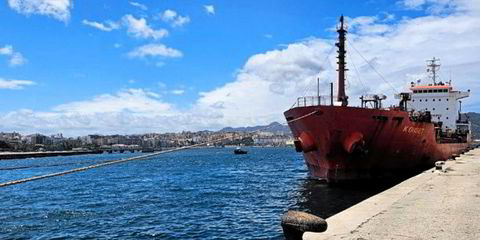Himalaya Shipping has filed its first batch of financial results as a fully operational shipowner, having taken delivery of four newbuildings during the first six months of 2023.
The Oslo and New York-listed outfit reported a net loss of $1.1m for the six-month period, which was worse than the $1m loss for the corresponding period last year.
With vessels on the water fixed on long-term contracts, the company was able to book $8.2m in revenue for the first half of this year.
Chief executive Herman Billung called the results the “first stepping stone in what is going to be many exciting years ahead”.
“We strongly believe that we have the right ships, at the right time,” he said. “The orderbook for capesize vessels is below 5% — a 25-year low. Most yards don’t have the capacity to build large dry bulk ships before well into 2027, and the prices quoted are above $86m for similar ships to ours.
“In addition, the ageing fleet coupled with the new environmental regulations coming, means we should have improved utilisation for the coming years.”
Two of Himalaya’s bulk carriers — the dual-fuel, 210,000-dwt newcastlemaxes Mount Norefjell and Mount Matterhorn (both built 2023) — were able to bunker with LNG marine fuel for the first time in late July.
“The ships can reduce CO2 emissions by more than 40% when running on LNG and are prepared to meet, as well as benefit from, more environmental regulations coming into force,” Billung said.
“With natural gas prices decreasing, being able to fuel our ships with LNG can give further economic benefit to Himalaya.
“We have the right financing with seven years fixed-rate interest rates, giving the company an attractive cash break-even.”
Operating expenses increased by $5.4m from the previous six-month period to $6.4m as the fleet went live. Per vessel, operating costs are around $6,200 per day.
In February, Himalaya amended its sale-leaseback agreements with AVIC International Leasing for the first four of its newbuildings to finance 90% of the cost of installing scrubbers on the vessels, roughly $2.2m per ship.
Billung said Himalaya has no plans to make further investments in ships, but ultimately intends to distribute its surplus cash to shareholders in monthly dividends.
“This is the right approach in a cyclical industry,” he said.
Proceeds from Himalaya’s IPO on the New York Stock Exchange in April gave the firm a liquidity injection of $44.9m in net equity proceeds.
Himalaya has free cash resources of $24.2m available as of 30 June, up from $300,000 at the end of 2022.
The Mount Norefjell, Mount Ita, Mount Etna and Mount Blanc were all delivered from New Times Shipbuilding in China during the first half of this year. The Mount Matterhorn was delivered in July and began a charter to Mercuria Shipping.
The first four vessels earned a gross average time charter equivalent rate of $25,700 per day during the six-month period.
Nine of Himalaya’s 12 ships have been fixed on period charters, mostly index-related contracts, to what were said to be “high-quality reputable counterparties”. TradeWinds understands the charterers include Koch Industries and Mercuria.
A further seven vessels will hit the water by the end of January next year, and Himalaya said the newbuilding programme is slightly ahead of schedule.
The whole fleet will be fitted with scrubbers and will be able to be fuelled with LNG, low-sulphur fuel oil or high-sulphur fuel oil.





